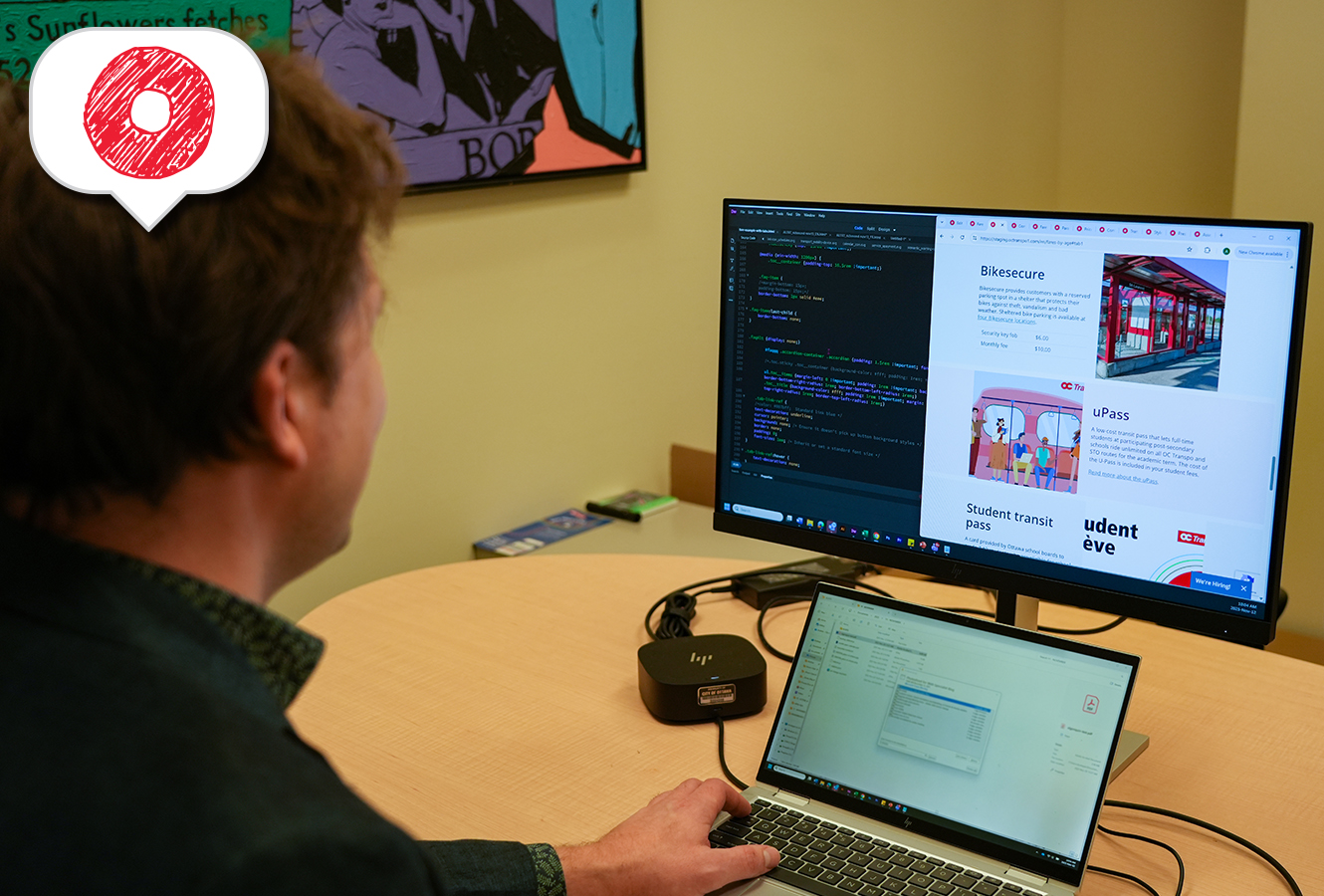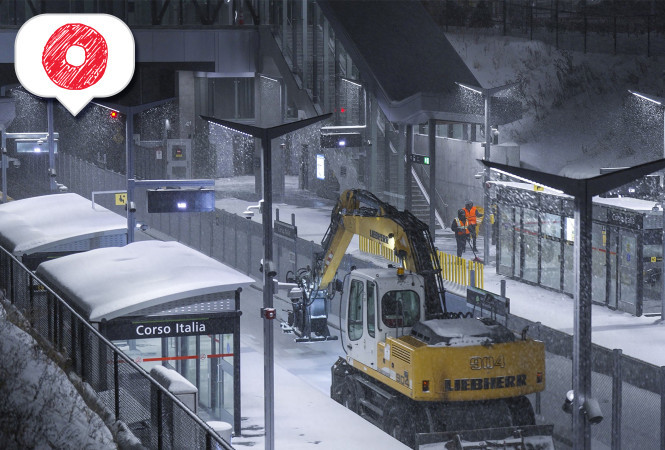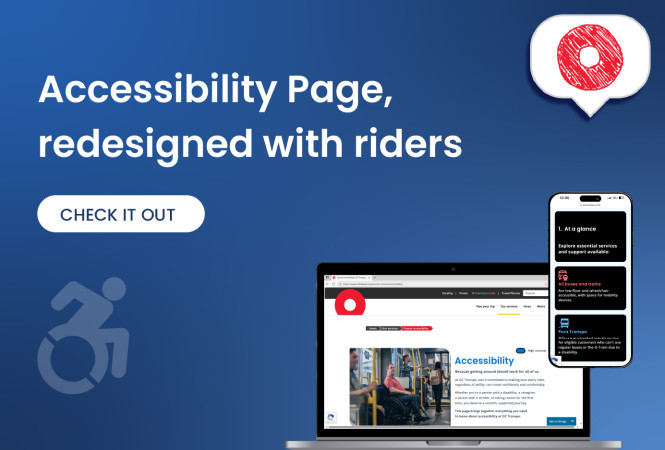It’s early in the morning, and an OC Transpo customer about to begin their commute types on their phone’s keyboard: octranspo.com
Once they hit enter, they are met with a comprehensive yet organized array of information — news articles, memos, construction notices, service alerts and more, right at their fingertips. They are one of thousands of customers who will use our website today to get the latest information on transit service. It’s the job of our hardworking website specialists to provide timely and accurate knowledge that they can rely on.
But what’s a typical day like? The Next Stop Blog shadowed the team to find out…
How the day unfolds
A web specialist’s day begins at 7:30 am with a scan of their inbox, specifically looking for feedback on the site. Any errors noted are corrected, and any urgent requests are actioned.
Our Website and User Experience (UX) Team is led by Francine, with Shannel, Andrew, Jihane and Judy as our dedicated website specialists. The website they oversee is as vast as the transit network it serves, with over 1,000 pages, 15,000 links, and 4,000 images.
With a site this large, it is especially important that customers can navigate with precision. The web team uses their expertise in content creation, usability, graphic design and accessibility to make this happen.
With the most pressing things taken care of, the Website and UX team goes for a strategy and brainstorming session led by Francine. Tasks are assigned, coffee is consumed, and timelines for upcoming projects are discussed. Today, one of the specialists raises that the site’s Fares page could benefit from a redesign. For the remainder of their meeting, the team collaborates on a plan to effectively update the page to better meet today’s customer information needs. The team devotes the remainder of their meeting to sketch out a project plan for renovating this webpage in order to better meet today’s customer information needs.
DING! The team just received an email about an upcoming bus route detour due to construction. Time to move to the next task: let customers know. When a planned detour is announced, they create updates for the Alerts page.
Information about the Where? When? and Why? of the detour is included, as well as turn-by-turn directions, stop impact tables showing where customers can catch their bus instead, and detailed maps.
In turn, this information is shared widely through social media posts, alerts on Transit Information Screens (TIS) at our stations, and even via SMS text messages and email alerts to customers who have registered to receive them.
It’s lunch time but before stopping for a bite, the team learns about an exciting initiative and a website specialist is tasked with letting riders know.
This time, it’s Tunes & Tracks: A celebration of sound and transit, a music-themed transit celebration led by EnviroCentre.
An interactive article is quickly prepared and sent for French translation—a key step for ensuring a fully bilingual website. Once posted, the article features links to the hosting transit stations, EnviroCentre’s website and our travel planning tools to help customers get to the concerts.
This is far from the only type of content that is published by our team of digital experts – accessible itineraries, info on discounts and deals like the 2-1 DayPass…
Posting planned detours and interactive articles touches on the three main goals of the OC Transpo website:
- Guiding riders from point A to point B
- Building trust through accurate and transparent content
- Showcasing new ways and reasons to use transit
The web team ensures all content is accessible for our website’s visitors, adhering to the international standard for accessibility, Web Content Accessibility Guidelines 2.0 (WCAG 2.0) at the AA level. This afternoon, an error is noted with the formatting of the French alternative text for an image, and a website specialist provides a quick fix to ensure the alternative text is communicated properly in both official languages.
Clean design, high-contrast text, plain language, and alternative text options for images and videos are just a few of the tools used to remove barriers for people with disabilities, ensuring that the website is an efficient and useful space for all. Alternative text is a textual description of an image or graphic and is a critical aspect for customers that are vision impaired and use screen readers.
“Behind every page we publish, there’s one question we ask first: would this help my neighbour, my kid, or my grandparent figure this out fast? We’re not here to impress; we’re here to help. Clear beats clever. That’s what guides us.”— Jihane
To learn more about how our website is designed with barrier-free browsing in mind, check out our Accessibility page.
Later in the afternoon, a website specialist checks in on the latest metrics for how customers have been using octranspo.com. Data-driven feedback offers insight into what parts of the website are most useful, as well as the paths customers take while browsing the site. Whether you prefer to find service updates on the home page, or heading to the Alerts page first is more your speed, the team is paying close attention to activity on the website to improve your experience.
“While we don't always receive feedback directly from riders, we can monitor online behavior through our web analytics. It's a good feeling when we see that users are hitting the right pages and finding the appropriate content in a timely manner -- it means we are doing our job right.”— Andrew
As the day winds down, let’s take a look at some of the fruits of the web team’s labour. Here are five of their favourite pages:
O-Train Extension Interactive Map
Spans the entire upcoming extension and includes public washrooms and key destinations across Ottawa.
Service Changes
Stay on top of seasonal adjustments and route changes — everything you need, in one place.
Help
Your one-stop shop for all transit questions. A true treasure trove of reliable info.
Transit Stations
Explore all 68 transit stations, with maps, platform locations, and local amenities.
Accessibility Page
Freshly redesigned for easier navigation. Now with high-contrast mode and clearer layout.
Browsing the future
As for what’s next, customers can expect exciting updates to the O-Train Extension website and the O-Train’s Interactive map released soon.
In the meantime, the team are busy making sure the website is ready for the future. Our site has been designed with Search Engine Optimization (SEO) in mind. This helps the AI powering your favourite search engine understand the information on the OC Transpo website and improve your search results. Our website specialists are also adopting the latest Generative Engine Optimization (GEO) best practices, to translate our content for your favourite AI tools and improve their answers.
Just like our constantly moving transit network, our website is in a constant state of evolution too. If you have feedback on the website, our web team would love to hear from you. Please fill out our Customer Feedback form and choose the “Website” category.


